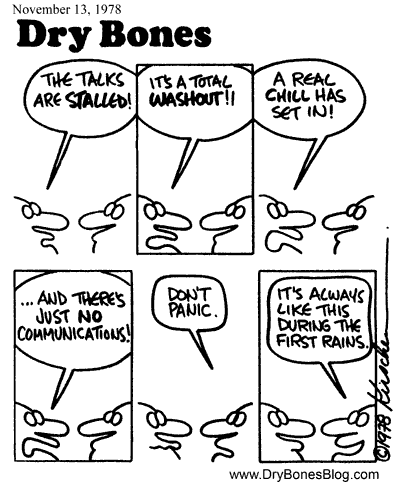
The Shulchan Aruch (Orach Chayim, 117:1) rules that in the 'Bar-aich Aleynu' beracha of the weekday Amida, there is a seasonal adjustment for winter. The phrase 'Ve-tain beracha' (and give blessing) is replaced with 'Ve-tain tal u'matar' (and give rain and blessing). For example, see page 218 in the green Siddur and page 270 in the Artscroll Siddur.
This of course is the source of the well worn joke, where a Yekke tells his wife that he will be home late from shul that night, due to the switch to Ve-tain tal u'matar!
Curiously, this adjustment is made according to a secular calendar to conincide with 60 days after the autumn equinox.
Why do we need to make this adjustment and why is it not based on the Jewish calendar?
The Talmud (Tractate Taanit 2a and other places in the first chapter) discusses when we should start praying for rain. For our purposes, this refers to what we say in the beracha of Bar-aich Aleynu. It does not refer to Mashiv Haruach umorid hagashem which is praise of G-d, not a request for rain, as evidenced by its placement in the first section of the Amida which deals solely with praise.
According to the Talmud (Taanit 10a), the prayer for rain is seasonal and therefore different customs arose in Israel and the Diaspora (for our purposes, the Diaspora means Babylon). In Israel, the switch ve-tein tal umatar is always made according to the Jewish calendar, on 7 Cheshvan. This suits the needs of the Land of Israel and in Temple times allowed pilgrims time to get home from Jerusalem to other parts of Israel without praying for themselves to get soaked on the way!
By contrast, Babylon was run according to a different calendar. The optimum time for rain in Babylon was 60 days after Tekufat Tishrei (the autumnal equixox - this is one for calendar lovers) and so the Halacha as applied in Babylon meant that was the time to start saying Tein Tal Umatar. Since the Babylonians did not use a Jewish calendar but used a calendar more similar to the Gregorian calendar we, who in the Diaspora are considered like the Babylonians for this purpose, follow the 60th day after the autumnal equinox which currently falls on 4 or 5 December depending on the year.
The ruling of the Shulchan Aruch, mentioned at the top, is based on the Rambam, Hilchot Tefila 2:16. In addition, the Beit Yosef, initially citing the ruling of the Rosh (Responsa 4:10), confirms after some lengthy discussion that Babylonian practice is applicable to the rest of the Diaspora as well.
For those who like the maths behind it, I am indebted to Philip Baigel and Russell Grossman of the Yeshurun Shul in Edgware for their mathematical explanation on Yeshurun's website:
Tal Umatar Has Started!
"We started saying Tal Umatar from the evening of 5th December in the weekday Amidah, 60 days after an event known as Tekufat Tishrei - the first day of the Autumn season, which starts on the 23rd September. This is when the area of Babylonian exile, roughly modern day Iraq and representing the diaspora, needed rain. Sixty days after 23rd September is November 21st. But we don't say Tal Umatar until the 4th of December because the calculation was originally based on a solar year of 365.25 days. We now know the solar calendar is 365.2425 days and this discrepancy of 11 minutes and 14 seconds means the Tekufah has moved forward at a rate of one day every 128 years.
By 1582 the discrepancy had reached 10 days. The Catholics, led by Pope Gregory XIII (that's him pictured [on the Yeshurn site], looks like a frum bloke) decided to drop the extra ten days from the then Julian calendar by making the day after Thursday, October 4, 1582 Friday October 15, in a new calendar named “Gregorian” in the Pope's honour. As a result the day which would have been September 23 according to the Julian calendar is October 7 of the Gregorian The 60th day following which is December 5. Since we begin Tal Umatar during Maariv, that's the night of December 4. Every fourth year, however the Tekufah begins after the time that stars are visible ('Tzeit hakochavim') on October 7. The 60th day on those years is therefore December 6, and Tal Umotor begins on the evening of December 5."
This works well for us Northern Hemisphere guys but what about countries in the Southern Hemisphere or those close to the Equator? One posek who dealt with this question was the famed Rabbi Shmuel Salant, (1816-1909)for many years the Rav of Jerusalem (not in the 'English' meaning recorded by Wikipedia!).
In 1898, R'Avraham Avar Hirshovitz, perhaps a student of Rabbi Salant, sent a question from Melbourne asking whether Tein tal umatar should be recited in Australia from 4/5 December, a time which is the middle of the Australian summer. Interestingly, R'Hirshovitz was not the only Aussie petitioner to approach Rabbi Salant (see Torat Rabeinu Shmuel Salant 1:3)
Chief Rabbi Nathan Marcus Adler of London had already ruled that the Jews of Australia should say Tein Tal Umatar, presumbaly for the reasons we outlined above. R'Hirshovitz demured but Rabbi Salant replied that Rabbi Adler had authority to make this ruling and that R'Hirshovitz should follow Rabbi Adler's ruling.
Got that one you Aussies!! No flippers!
Conclusion
The Diaspora follows the custom of Babylon, unifying the Diaspora.
1 comment:
wow!
Post a Comment